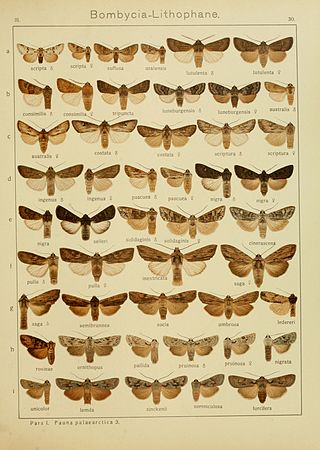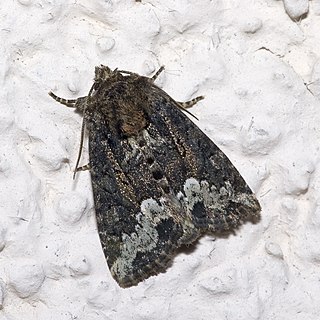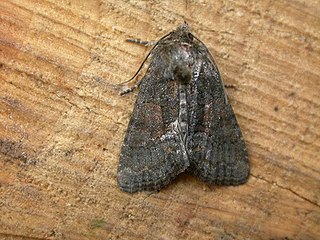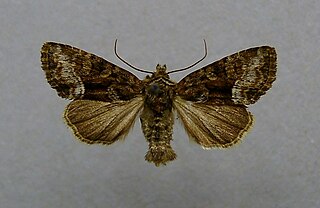
The garden dart is a moth of the family Noctuidae. It is distributed throughout much of the Palearctic. Temperate regions of Europe, Central Asia and North Asia, as well as the mountains of North Africa. Absent from polar regions, on Iceland and some Mediterranean islands, as well as in Macaronesia.

Agrotis segetum, sometimes known as the turnip moth, is a moth of the family Noctuidae. The species was first described by Michael Denis and Ignaz Schiffermüller in 1775. It is a common European species and it is found in Africa and across Eurasia except for the northernmost parts.

The heart and dart is a moth of the family Noctuidae. The species was first described by Carl Linnaeus in his 1758 10th edition of Systema Naturae. A familiar moth to many, it is considered one of the most common of the European region. It occurs throughout the Palearctic realm from Ireland to Japan.

The lesser yellow underwing is a moth of the family Noctuidae.

The ingrailed clay is a moth of the family Noctuidae. The species was first described by Johan Christian Fabricius in 1775. It is distributed through most of Europe and the Palearctic.

The small square-spot is a moth of the family Noctuidae. The species was first described by Karl Friedrich Vieweg in 1790. It is found in Europe apart from the far south-east then east through the Caucasus, Transcaucasia, Central Asia, Siberia, the Russian Far East and Kamchatka.

The six-striped rustic is a moth of the family Noctuidae. It is distributed throughout Europe apart from the far south east.

Mythimna impura, the smoky wainscot, is a moth of the family Noctuidae. The species was first described by Jacob Hübner in 1808. It is distributed throughout most of the Palearctic realm from Ireland in the west of Europe east to the Caucasus, Turkey, Syria, Kazakhstan, Russia, Siberia, Mongolia, then Japan. In Europe it is found from the Arctic Circle to Spain and Italy in the south, as well as in the northern regions of Greece.

The northern deep-brown dart is a moth of the family Noctuidae. It was first described by Christian Friedrich Freyer in 1848 and it is found in northern and western Europe.

The copper underwing, humped green fruitworm or pyramidal green fruitworm is a moth of the family Noctuidae. The species was first described by Carl Linnaeus in his 1758 10th edition of Systema Naturae.

Svensson's copper underwing is a moth of the family Noctuidae. The species was first described by Charles E. Rungs in 1949. It is distributed throughout Europe including Russia east to the Urals.

The dun-bar is a moth of the family Noctuidae. It is a common Palearctic species.

The marbled minor is a moth of the family Noctuidae. The species was first described by Carl Linnaeus in his 1758 10th edition of Systema Naturae. It is distributed throughout Europe, east through the Palearctic to central Asia and the Altai Mountains. It rises to heights of over 1500 meters in the Alps.

Oligia latruncula, the tawny marbled minor, is a species of moth belonging to the family Noctuidae. The species was first described by Michael Denis and Ignaz Schiffermüller in 1775. It is distributed throughout Europe from northern Scotland and middle Fennoscandia in the north and then south to central Spain, Sicily and Greece. In the east, the species ranges to Western Asia. In the Alps it rises to an altitude of 2000 meters.

Oligia versicolor, the rufous minor, is a species of moth belonging to the family Noctuidae. The species was first described by Moritz Balthasar Borkhausen in 1792. It is distributed throughout Europe from Bulgaria up to the Caucasus in the south. In the north, it is found in southern Scotland, southern Sweden and Estonia through Europe to central Spain, southern Italy.

Hoplodrina blanda is a moth of the family Noctuidae. It is found in the Palearctic realm.

Hoplodrina ambigua, the Vine's rustic, is a moth of the family Noctuidae. It is found in the western Palearctic realm.

Euxoa obelisca, the square-spot dart, is a moth of the family Noctuidae. It is found in the Palearctic realm.

Euxoa cursoria, the coast dart, is a moth of the family Noctuidae. It is found in northern and central Europe as well as the coastal regions of the British Isles, central Siberia, Mongolia, Tibet and Afghanistan. The subspecies Euxoa cursoria wirima is found in Canada.

Agrotis vestigialis, the archer's dart, is a moth of the family Noctuidae. The species was first described by Johann Siegfried Hufnagel in 1766. It is found in most of the Palearctic realm from Ireland east, through to Russia, Siberia, the Altai Mountains and the Amur region, and is also present in the Mediterranean Basin. It is absent from the north of Finland and Norway.
























